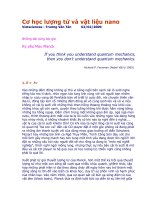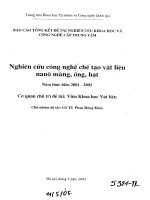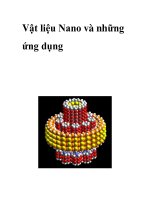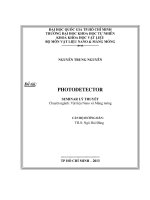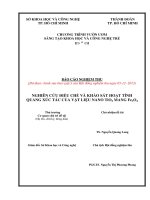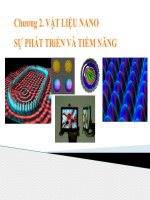Vật liệu nano và màng mỏng selection criteria for materials
Bạn đang xem bản rút gọn của tài liệu. Xem và tải ngay bản đầy đủ của tài liệu tại đây (2.46 MB, 33 trang )
co
ng
.c
om
Thermoelectrics for Energy
cu
u
du
o
ng
th
an
Selection Criteria for Candidate Materials
CuuDuongThanCong.com
/>
.c
om
ng
co
Increasing zT
th
an
Reducing Thermal Conductivity
cu
u
du
o
ng
One of the primary methods for increasing the zT is to reduce the thermal conductivity.
The thermal conductivity of a material is made up of two components, the lattice
component and the electronic component.
The electronic component of the thermal conductivity comes from the heat that
is transfered through the material via the charge carriers and is directly related to
the electrical conductivity (σ in the numerator). Therfore, reducing κe is not
beneficial to the zT.
The lattice component of the thermal conductivity is a result of heat transfer via
lattice vibrations, also known as phonons. κl is independent of the numerator and
thus reducing this value can contribute to an increase in the final zT value.
CuuDuongThanCong.com
/>
.c
om
ng
co
an
th
ng
du
o
u
cu
CuuDuongThanCong.com
/>
.c
om
ng
co
an
th
ng
du
o
u
cu
CuuDuongThanCong.com
/>
.c
om
There are several methods for reducing the lattice thermal conductivity of a material.
Each of these methods involves scattering the phonons as they move through the lattice
at different length scales.
co
ng
The three methods discussed below scatter phonons in three different scales: angstroms,
nanometers, and microns.
an
1. Angstroms:
du
o
ng
th
Substitution and doping methods involve replacing a fraction of one of the original
elements in the host material with an isoelectronic atom (substitution) or an atom with
±1 electron (n or p-type doping).
cu
u
This "impurity" atom is randomly dispersed throughout the unit cells of the material and
has a different size and mass than the atoms in the host matrix. Therefore, the phonons
traveling through the lattice experience a defect and are scattered on the atomic or
angstrom length scale.
CuuDuongThanCong.com
/>
2. Nanometers:
ng
.c
om
Phonons are scattered on the nanometer length scale by using nanoinclusions. These
inclusions are nano-scale particles incorporated into the material during synthesis or
sintering which may be made of the same compound or a unique material.
an
co
The nano-inclusions cause the phonons traveling through the material at the nanometer
scale to experience a defect and scatter, reducing the thermal conductivity.
ng
th
3. Microns:
u
du
o
Grain boundary engineering is used to scatter the long wavelength phonons in the range
of several microns. This is done by powder processing and adjusting the sintering
parameters in order to reduce the final grain size of the material.
cu
As phonons encounter a grain boundary they are scattered, thus increasing the number
of grains can reduce the lattice thermal conductivity on the micron length scale.
Each of these methods may be incorporated into a material individually or in
combination. Depending on the intrinsic thermal conductivity of the material, the
different methods may have different effectiveness in enhancing the overall zT value.
CuuDuongThanCong.com
/>
.c
om
ng
co
Increasing Power Factor
Host
atoms
(blue)
throughout the unit cell
are replaced by atoms
with
one
more
or one less electron (red),
changing the carrier
concentration of the
material
ng
th
an
The numerator of the above zT equation is often referred to as the power factor. By
increasing this value the zT of a material can be enhanced. The primary method for
increasing the power factor is doping.
cu
u
du
o
Doping is done by replacing one of the host atoms with an element with ± one electron
(compared to the host element). In doing this, the carrier concentration of the
compound can be tailored to the optimal level. Doping concentrations are usually rather
low (<15%) and often reach a solubility limit where the compound cannot be formed
homogeneously with large concentrations of the dopant atom.
The Seebeck coefficient and electrical conductivity are both dependant on the carrier
concentration and carrier mobility. Thus the ability to tailor the carrier concentration via
atomic doping is critical to optimizing the power factor.
CuuDuongThanCong.com
/>
th
an
co
ng
.c
om
Selection Criteria for Candidate Materials
du
o
u
‰Narrow band-gap semiconductors : For operation at room temperature
‰Heavy elements : High μ, low κ
‰Large unit cell, complex structure : low κ
‰Highly anisotropic or highly symmetric
‰Complex compositions : low κ, complex electronic structure
‰Mass Fluctuation : low κ
‰High density of states near the Fermi level : high Seebeck coefficient
cu
ng
Guiding Principles:
CuuDuongThanCong.com
/>
.c
om
ng
co
an
th
ng
du
o
u
cu
CuuDuongThanCong.com
/>
.c
om
ng
co
an
th
ng
du
o
u
cu
CuuDuongThanCong.com
/>
.c
om
ng
co
an
th
ng
du
o
u
cu
CuuDuongThanCong.com
/>
.c
om
ng
co
an
th
ng
du
o
u
cu
CuuDuongThanCong.com
/>
.c
om
Bismuth telluride (Bi2Te3) and its alloys are good thermoelectric materials
below room temperature.
an
co
ng
Above room temperature the relatively narrow band gap causes mixed
conduction due to both electrons and holes. This leads to reduced Seebeck
coefficient.
du
o
ng
th
Bismuth telluride can be alloyed with Sb2Te3 or Bi2Se3, which reduces thermal
conductivity considerably. Pseudo-ternary system of Bi2Te3-Sb2Te3-Sb2Se3 has
also been formed .
cu
u
Problems with tellurium arise, since it is scarce, toxic and volatile at high
temperatures. Therefore the use of tellurium is limited.
CuuDuongThanCong.com
/>
.c
om
Lead telluride (PbTe) was found to have good thermoelectric properties at
temperatures in the range of 300–700 K.
Similar materials are such as PbS and PbSe, which belong to chalcogenides system.
an
co
ng
Chalcogenide is chemical compound including at least one chalcogen (“ore
former”) ion (usually S, Se or Te) and electropositive element.
du
o
ng
th
Lead chalcogenides have a FCC structure and are polar semiconductors with a
mixed ionic-covalent bond with the electrons travelling mainly in the cation (Pb)
sublattice and the holes in the anion chalcogenide sublattice.
cu
u
PbTe has high mean atomic weight and a multi-valley band structure. The band gap
at 300 K is 0.32 eV, which produces higher Seebeck effect than that of bismuth
telluride.
Also its thermoelectric figure of merit (ZT) is higher when the temperature is raised
although it has better lattice thermal conductivity than bismuth telluride.
CuuDuongThanCong.com
/>
.c
om
PbTe- SnTe system have been studied since 1961.
co
ng
Lead telluride forms isomorphous solid solutions with lead selenide and tin
telluride, which leads to lower thermal conductivity and improved ZT values.
ng
th
an
Band gap goes to zero at Pb0.4Sn0.6Te and therefore lower compositions of tin
telluride are required to ensure adequate band gap leading to ZT values near 1 for
n-type PbTe-SnTe alloys at 700 K.
cu
u
du
o
Another system that gives similar properties are AgSbTe2 and GeTe.
CuuDuongThanCong.com
/>
.c
om
co
an
du
o
ng
th
Silicon has a large band gap and
therefore silicon rich alloys, such as
Si0.7Ge0.3, are suitable for high
temperature
applications
because
problems
with
minority
carrier
dominance do not arise.
ng
SiGe alloys are superior materials for
thermoelectric generation.
cu
u
The large phonon scattering ensures low
thermal conductivity without affecting
the electron mobility.
CuuDuongThanCong.com
/>
.c
om
Skutterudites (ReTm4M12) are complex materials containing rare earth elements
(Re), transition metals (Tm) and metalloids (M).
co
ng
Binary skutterudites have chemical formula of ReTm4M12, where Re is rare earth
element, Tm is transition metal and M is metalloid.
ng
th
an
Binary skutterudites have the chemical formula of TmM3 and relatively high
thermal conductivity, but the Seebeck coefficient is also relatively large.
cu
u
du
o
The crystal structure of binary skutterudites has two large empty spaces in each
unit cell. When the empty space is occupied by relatively heavy rare earth element,
the result will be reduced thermal conductivity due to rattling of the heavy element
within loosely bound lattice.
The figure of merit (ZT) has been found to be higher than unity at 700 K.
CuuDuongThanCong.com
/>
.c
om
Metal oxide thermoelectric materials
an
co
ng
A two-dimensional electron gas (2DEG) in SrTiO3. The 2DEG demonstrates a
Seebeck coefficient S that is enhanced by a factor of ~5 compared with the bulk
and an optimized ZT that reaches 2.4, twice that of conventional thermoelectric
materials.
cu
u
du
o
ng
th
Other new oxide materials developed in Japan are such as Na2CoO4, CaMnO3,
(ZnO)(In2O3), ZnO and CuAlO2.
CuuDuongThanCong.com
/>
.c
om
ng
co
an
th
ng
du
o
u
cu
CuuDuongThanCong.com
/>
.c
om
ng
co
an
th
ng
du
o
u
cu
CuuDuongThanCong.com
/>
.c
om
ng
co
an
th
ng
du
o
u
cu
CuuDuongThanCong.com
/>
.c
om
ng
co
an
th
ng
du
o
u
cu
CuuDuongThanCong.com
/>
.c
om
ng
co
an
th
ng
du
o
u
cu
CuuDuongThanCong.com
/>
cu
u
du
o
ng
th
an
co
ng
.c
om
Structural properties of as-deposited IGZO thin films
CuuDuongThanCong.com
Advances in Condensed Matter Physics. 971528 (2014)
Thin Solid Films. 583, 201 (2015)
/>
an
co
ng
.c
om
Electrical properties of as-grown and post-annelaed IGZO thin films
Post-annealed
cu
u
du
o
ng
th
As-grown
CuuDuongThanCong.com
Advances in Condensed Matter Physics. 971528 (2014)
Thin Solid Films. 583, 201 (2015)
/>

